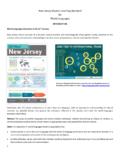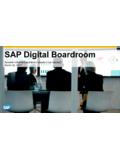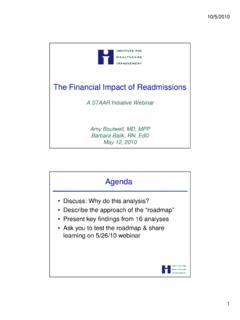Transcription of Data Analytics and Financial Compliance
1 data Analytics and Financial Compliance : How Technology is Changing Audit and Business SystemsJuly 2016 Sponsored byMichael P. Cangemi Author and Business AdvisorWilliam M. SinnettCOO, Research | FERF PA G E / 2 PA G E / 2 Executive Summary 3 SECTION 1 Understanding data Analytics Software Solutions 6 SECTION 2 Use of Analytics by Internal Auditors 8 SECTION 3 Use of Analytics by External Auditors 11 SECTION 4 The Future of Analytics in Audit 15 Appendix.
2 The AICPA s Audit data Standard 16 Professionals Interviewed for This Report 18 Bibliography 19 About the Authors 21 About RR Donnelley Financial Services 22 About Financial Executives Research Foundation 23 TABLE OF CONTENTS PA G E / 3 EXECUTIVE SUMMARYF inancial executives have witnessed a dramatic rise in Compliance -related expenses given regulations related to maintaining systems of internal control and the cost of internal and external audits.
3 Members of FEI s Committee on Finance & IT (CFIT) and Committee on GRC (CGRC) believe the use of Analytics has the potential to help management, and internal and external audit, improve systems and conduct more effective and efficient noted in FERF s 2014 Audit Fee Survey, the top reasons for the increase in audit fees in 2013 for public companies were the review of manual controls resulting from Public Company Accounting Oversight Board (PCAOB) inspections (40 percent) and other PCAOB issues (46 percent). In the 2015 report, review of manual controls and other PCAOB issues dropped to second place, garnering 39 percent of total responses (second to acquisitions at 46 percent).
4 As a result of PCAOB inspections, external auditors are challenged to provide consistently high-quality audits that meet the board s requirements and pass inspections. At the same time, as reported in the Wall Street Journal (March 8, 2016) audit firms are enlisting cutting-edge technology to help them review their clients finances. Advances in technology, specifically the use of automated Analytics , provide opportunities to improve the approach to internal control monitoring and audit verification. One of the significant trends enabled by technology is replacing sampling with automated reviews of entire populations of data .
5 Auditing standards and processes, many written before today s technologies were invented, will have to trend is the use of automated monitoring built into companies operating structures and core internal control systems. As this research report will show, these trends are being promoted by forward-thinking internal and external audit teams that focus not only on controls, but also on business process improvement, providing a more meaningful and cost-justified assurance internal controls can result in higher audit fees. The 2015 Audit Fee Survey found percent (or 1,460) of SEC filers reported ineffective ICFR (Internal Control over Financial Reporting).
6 The median change for audit fees of companies that disclosed ineffective ICFR was percent, which was 3 percentage points more than the overall median change in audit fees of percent, and percentage points more than the Average Producer Price Index for Services of data Analytics technology available today permits auditors to look at entire data sets, rather than manually reviewing statistical samples, so external auditors and internal auditors are both using technology to increase audit quality, work smarter and potentially reduce costs. Technology can be used to analyze the population and identify potential exceptions, anomalies and outliers, rather than just those found within a sample.
7 An important question for the regulators and the audit profession is how this might affect the auditor s find out how auditors are using technology, external auditors and internal auditors, as well as technology solution providers, were interviewed for this report. Here are some of the key findings: While it may be a common perception that audit firms want to bill as many hours as possible, we find that most auditors want to work efficiently with their clients. Regardless of regulatory requirements, business structure changes, inflation in the current business environment, or other factors that can drive up audit fees, many companies are finding ways to work with their auditors to mitigate fee increases.
8 Mitigating Increases in Audit Fees, FERF (2016) PA G E / 4 UNDERSTANDING data Analytics SOFTWARE SOLUTIONSA nalytics Software Vendors Views on the Use of Analytics data Analytics solutions provide the means to replace traditional sampling techniques with reviews of entire data populations. The identified potential exceptions and outliers can then be evaluated. Close the loop. Find the problem, and make a sustainable change in the internal control environment to prevent that problem from happening again. To manage a process, look at what the outputs are, measure them, appraise them, and make corrections or improvements.
9 The analytic output is not the end of the story. The individual consuming these insights needs to respond to them. The role of Analytics is to pursue the type of issues for which you can t create preventative controls Drivers For regulatory Compliance , examine every single transaction, customer and vendor. The goal of Analytics should be to minimize problems, rather than detecting more. Monitoring should be done by the business, as well as by internal audit. Analytics software customers want a sustainable improvement in the internal control environment. Analytics software customers look for hard-dollar recovered savings.
10 A reduction in duplicate payments or expenses is one metric of success. Score-carding can influence behavior by sending people meaningful grades of how they re behaving, with suggestions on how they can improve their OF Analytics BY INTERNAL AUDITORSG oals Audit quality is the primary goal of internal auditors. A second goal is to effectively analyze large data samples. A third goal is efficiency. Detection of duplicate payments is easy with Analytics , and can pay for the software. Analytics can be used to identify potential business risks, such as fraudulent payments and payroll fraud.







